Aberporth is a small town which lies at the southern end of Cardigan Bay, about six miles north of Cardigan and ten miles south of New Quay. In the 16th century, Aberporth was a subsidiary landing point for the port of Cardigan, and goods were brought in from Ireland. Aberporth developed a strong maritime trade in the late 17th and early 18th centuries, mainly due to the northernmost of the two beaches providing a safe anchorage. Limekilns, coalyards and warehouses were built on its south shore, and the town had a renowned herring fishing industry. The main work today comes from the local Ministry of Defence base, formerly known as RAE Aberporth, although it is a shadow of what is was when I worked there. The men of the Parishes of Aberporth and Blaenporth, who fell during both World Wars, are commemorated on the War Memorial, which is located within Hen Gapel Cemetery, and consists of a white marble figure of a serviceman, atop a black granite base, on which are inscribed the names of the fallen.
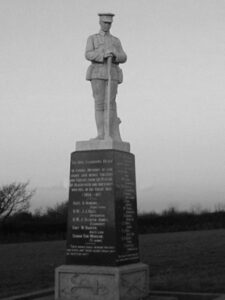
The Great War, 1914-1918
David John Davies, Private, 355816, Royal Welsh Fusiliers. David was born at Aberporth, the son of David and Nancy Davies, of Tyhen. He was the Brother of Miss Annie M. Davies, of Ty-Bryn Infirmary, Tredegar, Mon. David originally served with the Welsh Horse Yeomanry, after enlisting into the regiment at Newtown. The Welsh Horse formed in August 1914 in the southern counties of Wales, with headquarters at Cardiff. Later in the year it transferred to Newtown, before joining the 1/1st North Midland Mounted Brigade of 1st Mounted Division in the Diss area of Norfolk. During September 1915 the battalion was dismounted and sailed from Liverpool in the SS Olympic on 25 September, landing at Anzac, Gallipoli on 10 October 1915. The Welsh Horse were evacuated to Egypt in December 1915, and on 22 February 1916 formed part of the 3rd Dismounted Brigade, which was on Suez Canal Defences. On 4 March 1917 it merged with the 1/1st Montgomeryshire Yeomanry, and formed the 24th (Montgomeryshire and Welsh Horse Yeomanry) Battalion, Royal Welsh Fusiliers at Helmieh, Cairo, attached to 231 Brigade, 74th Division, fighting in Palestine, before moving to France in May 1918. David was killed in France, at the Battle of Épehy, on 18 September 1918. He was 24 years old, and is buried at Ste. Emilie Valley Cemetery, Villers-Faucon, France. A brother, Thomas Hywel Davies, died at sea in WW2.
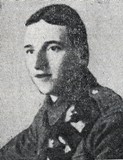
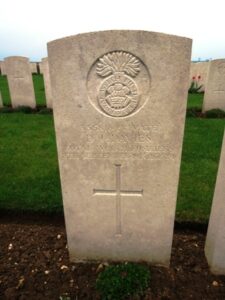
Thomas Edwards, Private, 9448, Royal Welsh Fusiliers. Thomas was born at Parcllyn, Aberporth in 1885, the son of John and Frances Edwards. He was an army reservist, and rejoined the colours at Cardiff at the outbreak of war. Thomas landed in France on 1 September 1914 with the 2nd Battalion, Royal Welsh Fusiliers. Thomas fought with the battalion at the First Battle of Ypres, where the German drive to the Channel coast was stopped, but he was wounded and returned home for treatment. He married Mary Ellen Rees at Merthyr Tydfil on 22 March 1915, prior to returning to France. On 4 April 1915 he was transferred to the 1st Battalion, Royal Welsh Fusiliers, which had suffered heavy casualties at Neuve Chappelle, whilst attached to 22 Brigade, 7th Division. During May they fought at the Battle of Aubers Ridge, and at Festubert. Thomas was killed at Festubert on 24 July 1915, aged 30. He has no known grave, and is commemorated on the Le Touret Memorial, Richebourg L’Avoue, France.
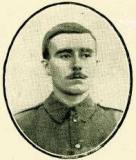
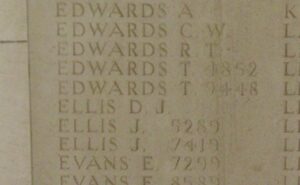
Richard William Picton Evans, MID, Major, Welsh Regiment. Richard was born at Cardigan in 1873, the son of William Picton Evans and Margarette Ellen Evans. His parents later resided at 13, Queen’s Road, Ealing, London. Richard was educated at Cheltenham College, and married Katherine Frances Blake in London in 1901, the couple moving to Argoes, Cardigan, where Richard ran his own Solicitor’s business. Katherine sadly died in 1909. Richard had served during the Boer War with the 1st Volunteer Battalion, Welsh Regiment, and by the outbreak of the Great War held the rank of Major, with the 4th Battalion, Welsh Regiment. He was posted at his own request to Alexandria in December 1916, joining the front line unit, the 1/4th Battalion, Welsh Regiment, which was attached to 158 Brigade, 53rd (Welsh) Division. Richard played a major part in the battalions subsequent war, seeing action during the three Battles of Gaza, and the triumphant capture of Jerusalem, being wounded at Gaza. Richard died in Palestine on 13 September 1918. He was 46 years old, and is buried at Gaza War Cemetery, Israel. His brother Lawrence also fell. Richard is not named on the Aberporth Memorial, but is commemorated on a plaque inside Blaenporth Church.
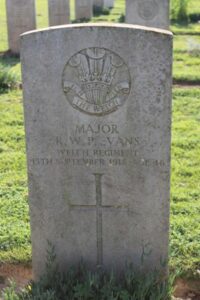
Thomas Griffiths, MM, Guardsman, 2759, Welsh Guards. Thomas was the son of Benjamin and Annie Griffiths, of Tymawr, Blaenporth. He enlisted at Brecon into the Welsh Guards, and was posted to France with the 1st Battalion, Welsh Guards in July 1915, which became attached to the 3rd Guards Brigade, Guards Division. The Welsh Guards saw their first major action during the Battle of Loos on 25 September 1915, remaining in the area during the coming months, where they also fought in the subsequent Action of Hohenzollern Redoubt. In July 1916 the Division moved to the Somme, where they fought at the Battle of Flers-Courcelette, and then at the Battle of Morval, capturing Lesboeufs Village. They remained here for the winter, and in March 1917 took part in the advance caused by the German Retreat to the Hindenburg Line. Later that year they moved north to Ypres, where they fought at the Battle of Pilkem, and then at the Battle of the Menin Road, Battle of Poelcapelle and the First Battle of Passchendaele. November saw them move south again, where they took part in the Battle of Cambrai, remaining in the Gouzeaucourt area after the Battle petered out. Thomas was killed in action at Gouzeaucourt on 10 March 1918. He was 28 years old, and is commemorated on the Arras Memorial, France. Thomas had been awarded the Military Medal during the war. It was published in the London Gazette of 16 November 1917, and was for the Battle of Passchendaele. The citation was published in the Tivyside, and read: ‘On 3 September 1917 he was in an advanced post with a Lewis Gun section, when a shell obtained a direct hit on the post, killing three of the team and wounding the other. Private Griffiths, though severely wounded, remained at his post until relieved that night and showed great devotion to duty and setting a very fine example.’ His brother David also served with the Welsh Guards.
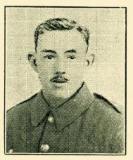
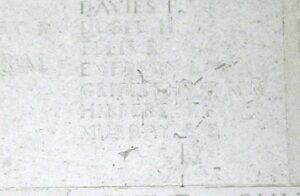
William David Harper, Second Engineer, Mercantile Marine. William was born at St Dogmaels in 1886, the son of William Henry and Jane Harper, of the White Lion. He resided with his wife, Mary Anna Harper (nee Harries), at 3, Grange Town, Cardigan. William served during the Great War aboard the London based SS Cayo Bonito, a defensively armed merchant ship. On 11 October 1917, whilst Cayo Bonito was four miles from Savona, she was torpedoed without warning and sunk by a German submarine. Six lives were lost, one of these being William David Harper. He is remembered alongside his shipmates on the Tower Hill Memorial, London.
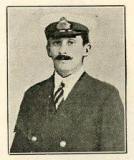
Joseph Selwyn James, Quartermaster, Mercantile Marine. Joseph was born at Ebbw Vale in 1899, the son of David and Sophia James. By 1911 the family were residing at Glanmordy, Aberporth. He served with the Mercantile Marine aboard HMHS Salta. She was a Hospital Ship, which had been chartered by the British Admiralty in February 1915. On 10 April 1917, while returning to pick up wounded soldiers at Le Havre, Salta struck a mine. A huge explosion smashed the hull near the stern, and in less than 10 minutes she sank. Of the 205 passengers and crew members, nine nurses, 42 members of the Royal Army Medical Corps and 79 crew drowned. Joseph was amongst the crew lost that day. He was 18 years old, and is buried at Ste. Marie Cemetery, Le Havre, France.
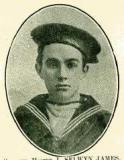
Thomas James, Third Engineer, Mercantile Marine. Thomas was born at Aberporth, the son of Benjamin and Mary Ann James. He had served at sea for many years prior to the war and lived with his wife Elizabeth Margaret James (nee Jenkins), at 12, Norfolk Road, Southampton. Thomas served as Third Engineer aboard H.M.H.T. Justicia, a Liverpool registered ship. On 19 July 1918 Justicia was en-route from Liverpool for New York when she was torpedoed and damaged by the German submarine UB-64, twenty miles off Skerryvore and was taken under tow. On 20 July 1918 Justicia was again torpedoed, this time by the German submarine UB-124, whilst under tow, and sank with the loss of eleven lives. Thomas was 46 years old when he died that day, and is commemorated on the Tower Hill Memorial, London. Thomas does not appear to be commemorated locally.
William Griffith James, Private, 19008, Welsh Regiment. William was the son of Simon and Frances James, of Esgairwilym, Blaenporth. He enlisted at Cardigan into the 8th Battalion, Welsh Regiment, which was attached to 40 Brigade, 13th (Western) Division. In January 1915 the battalion became the Pioneer Battalion to the Division, and on 15 June 1915 sailed from Avonmouth for Mudros, preparatory to landing at Anzac, Gallipoli on 5 August 1915. William joined the battalion at Gallipoli on 10 September, and was on the Peninsula during the terrible winter of 1915. On 8 January 1916, the Division was evacuated from Helles, and by 31 January was concentrated at Port Said, where they held forward posts in the Suez Canal defences. On 12 February 1916 the Division began to move to Mesopotamia, and took part in a hard campaign against the Turks. William was killed at Kut on 21 January 1917. He was 31 years old, and is buried at Amara War Cemetery, Iraq.
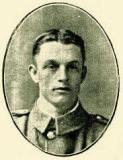
Owen Jenkins, Mate, Mercantile Marine. Owen was the son of Daniel and Mary Jenkins, of Aberporth. Prior to the war he resided with his wife, Hannah Jenkins (Nee Davies), at Craig-Y-Don, Aberporth. Owen served with the Mercantile Marine aboard the SS Greldon, a Cardiff registered steamer. On 8 October 1917, Greldon was about seven miles off Arklow Light Vessel, off the coast of Ireland, when she was attacked without warning by the German submarine U-96. A single torpedo sent her to the bottom, killing all 28 of her crew. Owen was 48 years old, and is commemorated alongside his shipmates on the Tower Hill Memorial, London.
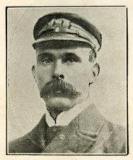
David Jones, Private, 8705, Welsh Regiment. David was born in 1885, the son of Thomas and Rachel Jones, of Bont, Aberporth. He was an army reservist, and rejoined the colours at Pembroke at the outbreak of war, landing in France on 29 November 1914, probably with the 1st Battalion, Welsh Regiment. David was later posted to the 18th Battalion, Welsh Regiment, which was raised in January 1915 as a Bantam Battalion, and went to Porthcawl attached to 43rd Division (later renumbered the 38th (Welsh) Division). In July 1915 the battalion moved to Prees Heath in 119 Brigade, 40th Division, and in June 1916 landed in France, moving to the front near Loos. Late in 1916 they moved south to the Somme, and fought at the Battle of the Ancre, and remained in the area over the winter. In March 1917 the Germans withdrew to their shortened line, called the Hindenburg Line, and the 40th Division were one of the Divisions that followed the withdrawal. Later in the year they took part in the Battle of Cambrai, playing an important role in the attack on Bourlon Wood. David was killed at Bourlon Wood on 23 November 1917. He was 32 years old, and is commemorated on the Cambrai Memorial, Louverval, France.
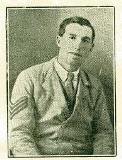
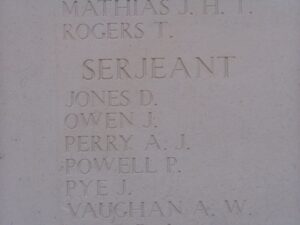
Gwilym Jones, Ordinary Seaman, J/88970 (Dev.), Royal Navy. Gwilym was born on 4 July 1899, the son of Thomas and Mary Jones, of Llwyn-ysgaw, near Aberporth. He enlisted into the Royal Navy and was posted to the training depot H.M.S. Vivid. He took ill and died of appendicitis in Plymouth Naval Hospital on 24 June 1918, aged 18. His remains were conveyed back to west Wales and Gwilym was buried in Twrgwyn Calvinistic Methodist Chapelyard, Rhydlewis. Gwilym does not appear to be commemorated locally.
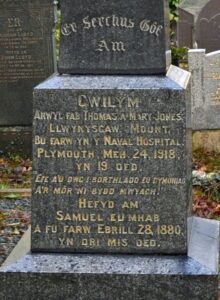
John Jones, Ships Cook, Mercantile Marine. John was born at Aberporth, the son of Henry and Phoebe Jones. He had been at sea for many years prior to the war and lived with his wife Elizabeth Jones (nee Evans), at Arthach, Cross Inn, Cardiganshire. John served as a cook aboard the Liverpool registered S.S. Eskmere. On 13 October 1917 Eskmere was en-route from Belfast for Barry when she was torpedoed by the German submarine UC-75 and sank off South Stack, Anglesey, with the loss of twenty lives. John was 50 years old when he died that day and is commemorated on the Tower Hill Memorial, London. John does not appear to be commemorated locally.
William Jones, Private, 6314, Welsh Regiment. William was born at Aberporth. He was an army reservist, and lived with his wife Annie Jones, at 16, Rice Street, Betws, Ammanford. He was a pre war regular, who had rejoined the army at Pontypridd at the outbreak of war, joining the 2nd Battalion, Welsh Regiment. The Battalion was attached to 3 Brigade, 1st Division, which had been one of the first to arrive in France, fighting at the Battle of Mons, and taking part in the retreat to the Marne, where the Germans were stopped. They then fought at the Aisne, and at Chivy, before being moved north to Ypres. Here they fought at the First Battle of Ypres, where they again stopped the German Offensive, before wintering in Flanders, where they took part in the Defence of Givenchy. William was killed in action here on 21 December 1914 aged 32. He is buried at Brown’s Road Military Cemetery, Festubert. William does not appear to be commemorated locally, but at Ammanford.
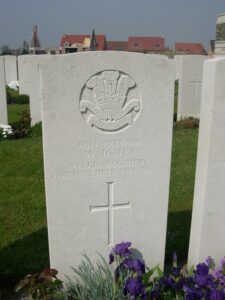
Tom Kane, Private, 37771, Welsh Regiment. Tom was born at Llangoedmor in 1881, and resided at Penffin, Blaenporth prior to the war, with his wife Ann. He enlisted at Cardiff into the 8th Battalion, Welsh Regiment, which was attached to 40 Brigade, 13th (Western) Division. In January 1915 the battalion became the Pioneer Battalion to the Division, and on 15 June 1915 sailed from Avonmouth for Mudros, preparatory to landing at Anzac, Gallipoli on 5 August 1915. Ton joined the battalion at Gallipoli on 10 October, and was on the Peninsula during the terrible winter of 1915. On 8 January 1916, the Division was evacuated from Helles, and by 31 January was concentrated at Port Said, where they held forward posts in the Suez Canal defences. On 12 February 1916 the Division began to move to Mesopotamia, and took part in a hard campaign against the Turks. Tom was wounded during the drive into Mesopotamia, and died there on 9 March 1917, aged 35. He has no known grave, and is commemorated on the Basra Memorial, Iraq. Tom is also commemorated on a plaque inside Blaenporth Church.
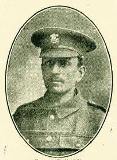
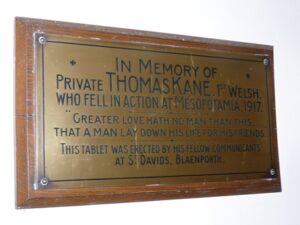
Thomas Morgan, Boatswain (Bosun), Mercantile Marine. Thomas was born at Ty-Mawr, Aberporth in 1863, the son of Thomas and Elizabeth Morgan. He served with the Mercantile Marine aboard the SS Mavisbrook, a Glasgow) registered steamer. On 17 May 1918, she was on route from Cardiff to Malta with a cargo of coal, when she was torpedoed by the German submarine UB-50, and sank. Thomas was among 18 of her crew who died aboard her that day. He was 55 years old, and is commemorated alongside his shipmates on the Tower Hill Memorial, London.
Thomas Aeron Morgans, Private, 27795, Welsh Regiment. Thomas was born at Rhydymul, Cilgerran, the son of Thomas and Catherine Morgans. The family later resided at Roadside, Blaenporth. He resided in Ferndale prior to the war, and enlisted at Cardiff into the Army, joining the 18th Battalion, Welsh Regiment, which was a Bantam battalion, made up of men below the minimum height requirements, which trained at Prees Heath in Shropshire. Here they became attached to 119 Brigade, 40th (Bantam) Division, and moved to France in June 1916 and moved to positions near Loos. Late in 1916 they moved south to the Somme, and fought at the Battle of the Ancre, and remained in the area over the winter. In March 1917 the Germans withdrew to their shortened line, called the Hindenburg Line, and the 40th Division were one of the Divisions that followed the withdrawal. Later in the year they took part in the Battle of Cambrai, playing an important role in the attack on Bourlon Wood. Thomas was killed in action here on 24 November 1917. He was just 20 years old, and is commemorated on the Cambrai Memorial, Louverval, France. Thomas does not appear to be commemorated locally, but at Cilgerran.
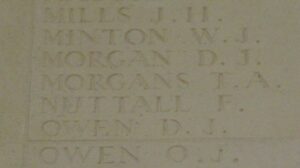
Henry James Owen, Second Lieutenant, Royal Welsh Fusiliers. Henry was the son of Captain Thomas Owen and Ellen Owen, of Ivy Cottage, Aberporth. He was commissioned into the Royal Welsh Fusiliers, and was posted to France, where he joined the 16th Battalion, Royal Welsh Fusiliers on 16 July 1918. The battalion had been in France since December 1915, attached to 113 Brigade, 38th (Welsh) Division, and had taken part in the capture of Mametz Wood in July 1916, and Pilckem Ridge in July 1917. Over the winter of 1917-18 the Division was stationed around the Armentieres area, and at the end of March 1918 was moved south to the Somme, to bolster the British defences there after the German offensive of 21 March. The Division remained here over the coming months, holding the line north of Albert towards Beaumont Hamel. Henry joined the battalion here. On 21 August 1918, elements of the 38th Division crossed the River Ancre, and consolidated positions in readiness for a general assault. On 23 August the 16th RWF moved into position, and on the morning of 24 August 1918 crossed the River Ancre, and assaulted the German positions at La Boiselle. Henry was killed in action here by German machine-gun fire that day. He was 28 years old, and is buried at Ovillers Military Cemetery, France.
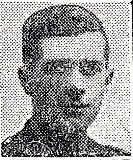
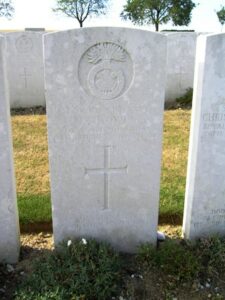
William David Prosser, Private, 266592, Welsh Regiment. William was born at Blaenllechau, Rhondda in 1900. By 1911 he was living with his grandparents, Simon and Frances James, of Esgairwilym, Blaenporth. William enlisted on 25 July 1916 into the 4th (Reserve) Battalion, the Welsh Regiment. He was posted to France on 2 February 1918, and joined the 9th Battalion, Welsh Regiment, which was in positions near Bapaume, attached to 58 Brigade, 19th (Western) Division. William reached the battalion on 19 February, but was in action for little more than a week before he was seriously wounded, suffering a gunshot wound to his arm, and shell fragments to his leg and body, which fractured his humorous. William underwent several months of treatment at the 3rd Scottish General Hospital, before being discharged as unfit on 21 January 1919. He went to live with his Uncle, Thomas Price, at 72, High Street, Ferndale, but died there after suffering an epileptic seizure on 2 May 1919, aged 20. William’s body was brought back to Aberporth, and he is buried in the Esgairwilym plot along with his grandparents and his sister Margaret Amelia.
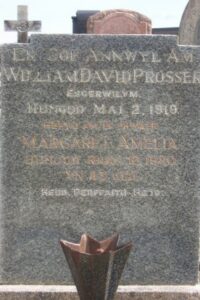
John James Rees, Quartermaster, Mercantile Marine. John was born in 1898, the son of James and Mary Rees, of Brynarfor, Aberporth. He served with the Mercantile Marine aboard HMHS Salta. She was a Hospital Ship, which had been chartered by the British Admiralty in February 1915. On 10 April 1917, while returning to pick up wounded soldiers at Le Havre, Salta struck a mine. A huge explosion smashed the hull near the stern, and in less than 10 minutes she sank. Of the 205 passengers and crew members, nine nurses, 42 members of the Royal Army Medical Corps and 79 crew drowned. John was amongst the crew lost that day. He was 19 years old, and is commemorated on the Salta Memorial at Ste. Marie Cemetery, Le Havre, France.
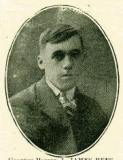
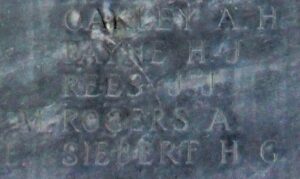
Lemuel Thomas Rees, Private, 29573, South Wales Borderers. Lemuel was born in 1895, the son of John and Sarah Rees, of Blaenanerch. He enlisted at Brecon into the South Wales Borderers, and was posted to France in 1916, joining the 6th Battalion, South Wales Borderers, which was the Pioneer Battalion to the 25th Division. The Division had been in France since 26 September 1915, and defended Vimy Ridge against a German attack in May 1916. They then moved to the Somme, and attacked on 3 July near Thiepval. They fought throughout the Battle of the Somme, and then moved to Ploegsteert, where they held the line for the months leading up the Battle of Messines in June 1917. After fighting at Messines, the Division moved north, and fought at Pilckem, before moving south again, where they took up positions around Bullecourt in March 1918, where it was used to reinforce the badly depleted British units that were hit in the area by the German Spring Offensive. They moved north to Flanders to rest on 30 March 1918, but were caught up in the German Lys Offensive, suffering heavy casualties before being moved to the Aisne to rebuild. On 26 May 1918 they took up positions south of the Aisne, to guard against a predicted German Offensive, which hit them the following day, and during the coming days the Division was virtually annihilated. The Division moved to England to rebuild, returning to France in September, and taking part in the 100 days offensive. Lemuel had survived the war, but had been evacuated sick to Wimille. He died there on 13 November 1918, aged 23, and is buried at Terlincthun British Cemetery, Wimille, France.
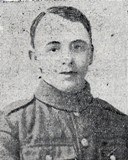
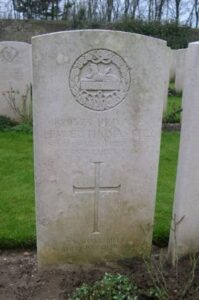
David Thomas, Lamps and Able Seaman, Mercantile Marine. David was born at Aberporth, the son of Mr. and Mrs. Margaret Thomas. He had served at sea for many years prior to the war and lived with his wife Mary Thomas (nee Evans), at 200, City Road, Cardiff. David served aboard the West Hartlepool registered S.S. Boscastle. On 7 April 1918 Boscastle was steaming off Strumble Head when she was torpedoed and sunk by a German submarine with the loss of eighteen lives. David was 68 years old when he died that day, and is commemorated on the Tower Hill Memorial, London. David does not appear to be commemorated locally.
David James Thomas, Private, 12968, Royal Welsh Fusiliers. David was born at Rhosygilwen, Blaenporth in 1893, the son of James and Ellen Thomas. He resided at 23, Railway Terrace, Tumble prior to the war. David enlisted there into the 9th Battalion, Royal Welsh Fusiliers, which was attached to 58 Brigade, 19th (Western) Division. The Division assembled around Bulford during September 1914, and Divisional training was completed near Tidworth, from March 1915. The Division crossed to France between 11 and 21 July 1915, and moved to positions near Loos, where it took part in the opening attack of the Battle of Loos on 25 September 1915. The following year the Division moved to the Somme, where it took part in the second wave of the attack on Ovillers-La Boiselle on 1 July, capturing the village at heavy cost. It then fought through the Somme Battles of Pozieres, which is where David was wounded. He died of his wounds on 10 August 1916, aged 23, and is buried at La Clytte Military Cemetery, Belgium. (The Memorial names J. Thomas, who is possibly the man below, but David James Thomas was also from Blaenporth).
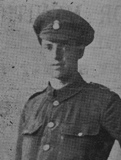
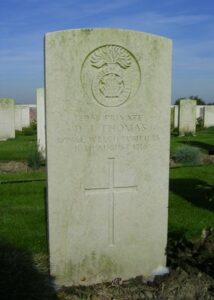
John Thomas, Private, 40680, York and Lancaster Regiment. John was the son of James and Mary Thomas, of Pennar Lodge, Aberporth. He worked as a Farm Labourer at Court Farm, Llangoedmore prior to the war, and enlisted at Cardigan on 5 June 1916, and was mobilised on 19 October 1916 into the Royal Field Artillery, with the service number 162088. On 26 November 1916 John was posted to France on 7 January 1917, joining the 10th Battalion, York and Lancaster Regiment, which was attached to 63 Brigade, 37th Division. The division was at Loos, and at the end of February 1917 moved to the Arras sector, taking part in the Battle of Arras, where John saw his first major action, during the capture of Monchy-le-Preux. The 37th Division then took part in two assaults on Greenland Hill, near the village of Gavrelle. John was killed in action here on 28 April 1917. He was 26 years old, and is buried in Chili Trench Cemetery, Gavrelle, France.
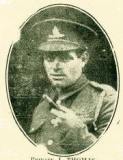
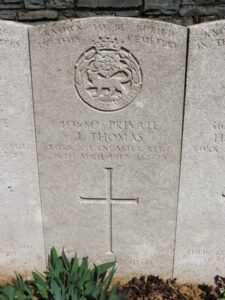
William Owen Thomas, Private, 29616, South Wales Borderers. William was born around 1892, in Penanteryn, Blaenporth, the son of David and Hetty Thomas. He married Elizabeth Jones, of Glandwr, Beulah in 1916. William enlisted at Brecon into the 5th Battalion, South Wales Borderers, who formed part of 58 Brigade, 19th (Western) Division. The Division fought at the Somme, suffering heavy casualties, and was moved to Ypres, where they took part in the Battle of Messines, which was the opening move of the Battle of Passchendaele. William was killed in action at ‘Whitesheets’ on 7 June 1917, and was buried in Wytschaete Military Cemetery, Belgium. Elizabeth later married David T. Owen, and the couple resided at Furze Hill, Cefneithin.
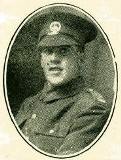
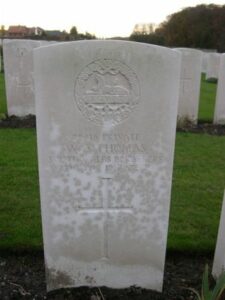
Llewellyn Watkins Howell Tringham, Captain, 21st (Empress of India’s) Lancers. Llewellyn was born at Shepherd’s Bush in 1870, the son of William and Margaretta Tringham. By 1881 the family were residing at Penygraig, Aberporth. Llewellyn had been in the army since prior to 1899, after having been commissioned into the 3rd Battalion, Royal Welsh Fusiliers. By the outbreak of the Great War he was serving with the 21st Lancers, but was transferred to 51st Brigade Headquarters, Royal Garrison Artillery. Llewellyn was wounded during the 100 days offensive, early in November 1918, and was evacuated to the Base Hospital at Rouen. He died of his wounds there on 22 November 1918, and is buried at St. Sever Cemetery Extension, Rouen, France.
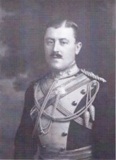
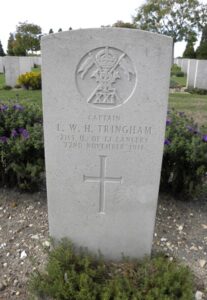
James Thomas Wade, Private, 29536, South Wales Borderers. James was born at Plaistow, London in 1895, the son of Henry and Eliza Wade. By 1911 he was residing at The Crown, Aberporth, working as a farm labourer. He enlisted at Cardigan into the army, and was posted to France with the 11th Battalion, South Wales Borderers, which was attached to 115 Brigade, 38th (Welsh) Division. The Division landed in France early in December 1915, and took up positions near Festubert, where it was initiated into trench warfare. In June 1916 the Division marched south to the Somme, where it captured Mametz Wood between 7 and 11 July 1916. After a brief spell at Hébuterne, the Division was moved north, taking up the line north of Ypres, along the Yser Canal at Boesinghe. It held the sector for almost a year, until launching its famous assault on Pilckem Ridge on 31 July 1917. James was killed in action at Pilckem during the attack that day. He has no known grave, and is commemorated on the Ypres (Menin Gate) Memorial, Belgium.
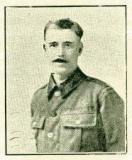
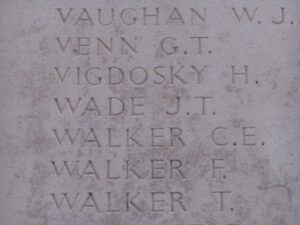
Henry Lloyd Williams, Private, 11875, Royal Welsh Fusiliers. Henry was the son of Mrs. Margaret Williams, of Afon Rhos, Llanrug, Carnarvon. He was working as a farm labourer at Blaenannerch at the outbreak of war and enlisted at Wrexham into the Royal Welsh Fusiliers. He trained at Kinmel Park prior to being posted to the Balkans on 28 May 1915. At some time afterwards he was posted to France, joining the 2nd Battalion, Royal Welsh Fusiliers. During February 1918 the battalion was attached to 115 Brigade, 38th (Welsh) Division. It moved to the Somme with the division at the end of March, and took up positions overlooking Aveluy Wood, north of Albert. Henry was killed at Bouzincourt Ridge on 22 April 1918, aged 23. He has no known grave and is commemorated on the Pozières Memorial, France. Henry does not appear to be commemorated locally.
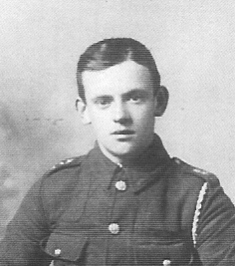
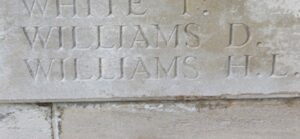
World War Two, 1939-1945
Evan David Bowen, Able Seaman, D/JX 288424, Royal Navy. Evan was the son of Evan and Mary Bowen, of Blue Fields Farm, Aberporth. He married Stella Driver in 1934. Evan served with the Royal Navy aboard the destroyer H.M.S. Mahratta, which had been commissioned in April 1943. She had a busy war, taking part in escort duties with several convoys. On 25 February 1944, Mahratta was escorting Convoy JW 57, which was being stalked by several German U-Boats. Mahratta was torpedoed and sunk by the submarine U-990 that day, with the loss of 220 lives. Evan was 37 years old when he died that day, and is commemorated on the Plymouth Naval Memorial, Devon.
John James Cole, Carpenter, Merchant Navy. John was the son of Tom and Jane Cole, of Tremain. Prior to the war he resided with his wife, Rita Cole, at Porth House, Aberporth. John served with the Merchant Navy, as a Carpenter aboard SS Blairatholl, a Glasgow registered cargo ship. On 27 November 1942, Blairatholl collided with a Dutch Merchant ship and sank. John was 27 years old when he died in the sinking, and he is commemorated on the Tower Hill Memorial, London.
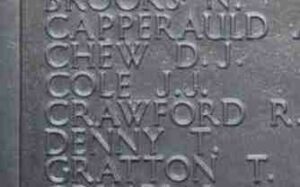
David Owen Davies, Able Seaman, D/JX 214757, Royal Navy. David was the son of John Thomas Davies and Martha Davies, of London House, Aberporth. He served with the Royal Navy at HMS President III. Edward had been posted aboard the steam merchant ship Erna II as a DEMS Gunner. He was killed when Erna II was torpedoed and sunk by the German submarine U-562 on 25 September 1941, while en-route from Swansea to Montreal. David was 21 years old, and is commemorated on the Plymouth Naval Memorial, Devon. He is also commemorated on a memorial at Bethany Chapel, Burry Port and at Yr Hen Gapel, Llanbrynmair. For some reason the CWGC incorrectly show him as Edward Owen Davies, but all other records show that he is definitely David Owen Davies.
Evan John Davies, Able Seaman, Merchant Navy. Evan was the son of Jane Davies, of Henllys, Aberporth. He served with the Merchant Navy aboard the MV Empire Dawn, a Sunderland registered cargo ship. On 12 September 1942, Empire Dawn was en route from Suez to Trinidad to load a cargo of bauxite, when she was attacked by the German surface raider Michel in the Atlantic. The ship was badly damaged by shellfire and started to sink, so the surviving crew took to the ships lifeboats. Evan seems to have been among 21 survivors from Empire Dawn who were taken prisoner by the Germans, who in turn handed the men over to the Japanese who took them to Tg Prick, Batavia. He died whilst being transported aboard a POW ship that was sunk on 24 June 1944. Evan was 25 years old, and is commemorated on the Tower Hill Memorial, London.
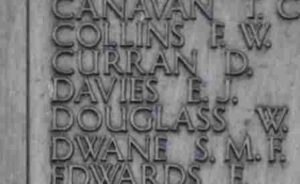
Thomas Hywel Davies, Second Officer, Merchant Navy. Thomas was born on 17 March 1896, the son of David and Nansi Davies, of Tyhen, Aberporth. He was educated at Llandyssul Grammar School before going to sea and joined the Merchant Navy, gaining his certificate as Second Mate of a foreign going steamship on 24 January 1924. He married Esme Joyce Fowler in 1936 and by 1939 the couple were living at Ogof, Aberporth, where he gave his occupation as fisherman. Thomas went back to sea following the outbreak of war and was posted aboard the Hull registered steamship SS Portsea. On 24 July 1944 Portsea was steaming off Ancona when she struck a mine and sank with the loss of over 20 lives. Thomas was 48 years old, and is commemorated on the Tower Hill Memorial, London. A brother, David John Davies, had been killed in WW1. His widow, Esme, passed away on 10 January 2000.
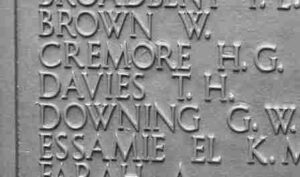
Stephen James Evans, Guardsman, 2616689, Grenadier Guards. Stephen was born at Llangrannog on 14 February 1922, the son of David John and Edith Evans. Little is currently known of him, but he died at home on 16 November 1946, aged 24, of wounds suffered during the war. He is buried in Aberporth (St. Cynwyl) Churchyard. Stephen does not seem to be commemorated locally.
Thomas Arthur Evans, First Electrician, Merchant Navy. Thomas was born on 2 October 1908, the son of Captain Ben Evans and Keziah Mary Evans, and resided at Penaruchaf, Aberporth. He served as an electrician in the Merchant Navy, aboard the Blue Star Line cargo vessel MV California Star. On 4 March 1943 she was when en-route from Wellington and Cristobal for Liverpool carrying a 6,434 ton general and refrigerated cargo when she was torpedoed by the German submarine U-515 and sunk with the loss of 45 lives. Thomas was 34 years old when he died that day and is commemorated on the Tower Hill Memorial, London.
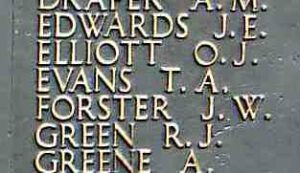
David Philip Griffiths, Carpenter, Merchant Navy. David was the son of Thomas and Sarah Ann Griffiths, of Beulah. He resided at Bowls, Blaenporth prior to the war, and served in the Merchant Navy aboard the SS Newton Pine, a Cardiff registered cargo steamer. On 16 October 1942, she was on route from Hull for Halifax in ballast when she was torpedoed by the German submarine U-410, and sunk with the loss of all of her crew of 47. David was 20 years old when he died that day, and is commemorated on the Tower Hill Memorial, London. There is also a memorial to David in Blaenporth Church.
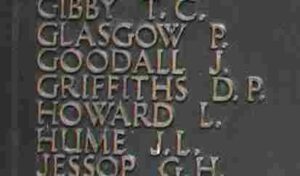
Reverend Dewi Henry James, Chaplain (Squadron Leader), 106645, Royal Air Force Volunteer Reserve. Dewi was the son of Samuel and Margaret James, of Cwrt-Hen, Beulah, Newcastle Emlyn. Prior to the war he resided with his wife, Megan, at Newport, Gwent, where he was a Minister of Religion at Mynydd Seion Chapel, High Street. Dewi volunteered to serve as a Chaplain (Squadron Leader) with the Royal Air Force Volunteer Reserve. After the invasion of occupied Europe, Dewi was among a large party of RAF servicemen who, along with trucks and supplies for the RAF in Belgium, were aboard the Landing Ship LST-420. It was unable to enter the port of Ostend because of a severe storm and the captain decided to return to England, but hit a mine, split in two, and sank. Fourteen officers and 224 other ranks were lost, with only 31 men saved. Dewi was lost in the sinking on 7 November 1944. He was 28 years old, and is commemorated on the Runnymede Memorial, Surrey.
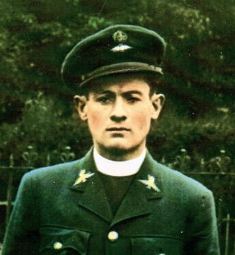
Charles Frederick Johns, Trooper, 7908536, Royal Armoured Corps. Charles, known as Frederick, was born at Cenarth on 19 January 1916, the son of Osborne Morgan Johns and Axa Johns (nee Jones). The family moved to Delfryn, Aberporth at some time afterwards. Charles married Laurie Nellie Bridgement at Wellingborough, Northants, in the summer of 1941 and the following year their only child, Megan, was born. Frederick had enlisted into the army and served with the 15th/19th The King’s Royal Hussars, which was an armoured cavalry unit, attached to the Royal Armoured Corps. The 15th/19th Hussars remained in the United Kingdom until after the Normandy landings, on 6 June 1944, then was dispatched to France on 17 August 1944 to serve as the divisional reconnaissance regiment of the 11th Armoured Division, joining the advance through Northern France and Belgium towards Holland. During the morning of 10 September 1944, Charles’s regiment was in position covering the crossings of the Albert Canal near Beringen. The regiment advanced northwards that morning, then encountered German anti-tank guns in the area of Voorter-Heide. Charles was killed that morning, when his tank, commanded by Lieutenant Pearson, was hit in the front by a German shell whilst engaging SS positions. The 28-year-old was buried in Hasselt (Kruisveld) Communal Cemetery, Belgium.

John Seymour Jones, Able Seaman, Merchant Navy. John was born on 4 December 1909, the son of John Griffith Jones and Mary Ann Jones (nee Davies), of Penlan, Aberporth. He married Ann Mary Thoams in 1934 and the couple moved to Camden Town, London. John served with the Merchant Navy, aboard the Hull registered cargo steamer, SS Albionic. On 31 August 1940, Albionic left Wabana, Newfoundland, bound for Liverpool, with a cargo of some 3,500 tons of iron ore. During the morning of 11 September 1940 Albionic, sailing unescorted, was attacked and torpedoed by the German submarine U-99 and sank some 70 miles south of Rockall, with the loss of all 25 men aboard. John was 30 years old when he died that day, and is commemorated on the Tower Hill Memorial, London.
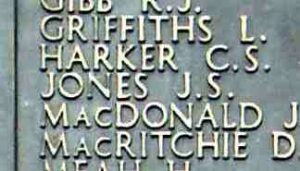
Samuel Walwyn Parry Jones, Chief Officer, Merchant Navy. Samuel was born in Beulah in 1908, the son of Owen Parry Jones and Margaret Ellen Jones. The family later resided at Llety, Aberporth, while Samuel and his wife Bertha Mary Parry Jones (nee Jarvis) briefly lived at Briton Ferry after marrying in 1942. Samuel served with the Merchant Navy as Chief Officer aboard the London registered oil tanker M.V. Eulima. On 23 February 1943 Eulima was en-route from Liverpool for New York in Convoy ON-166 when she was torpedoed and sunk by the German submarine U-186, with the loss of 86 lives. Samuel was 35 years old when he died that day and is commemorated on the Tower Hill Memorial, London.
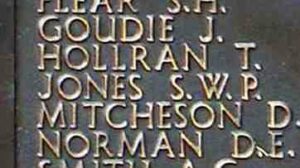
John Morris Nicholas, Able Seaman, Merchant Navy. John was the son of David and Hannah Nicholas, of Brynmor, Aberporth. He served with the Merchant Navy aboard the SS Empire Hawksbill, a London registered cargo vessel. On 19 July 1942, Empire Hawksbill was 200 miles off the Azores, when she was torpedoed and sunk by the German submarine U-564. The Master, all thirty-seven crew and nine gunners were lost. John was 42 years old when he died that day, and he is commemorated on the Tower Hill Memorial, London.
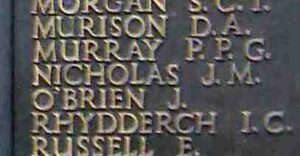
David Harrop Owens, Sub-Lieutenant, Royal Naval Volunteer Reserve. David was the son of David and Isabella Owens, of Brohedyn, Aberporth. He served with the Royal Naval Volunteer Reserve, aboard HM Trawler Rubens. Rubens was a Belgian fishing vessel, hired August in 1940 and converted for anti-submarine duties. She was attacked and sunk by German aircraft in the Western Approaches on 21 January 1941. David was killed during the attack. He was 26 years old, and is commemorated on the Lowestoft Naval Memorial, Suffolk.
T. Richards, Able Seaman, Merchant Navy. This man resided at Plas-y-Llan, Aberporth, but cannot presently be identified.
Clifford Rock, Guardsman, 2732946, Welsh Guards. Clifford was the son of John and Mary Rock, of Abercarn, and the husband of Rachel Annie Rock (nee James), of Aberporth. At the outbreak of war Clifford was serving with the Welsh Guards, and was posted to France with the BEF, attached to the 2nd Battalion, Welsh Guards. The Battalion famously defended the city of Arras during the fall of France, before retreating west to Boulogne, where it again fought a famous defensive battle in the attempt to allow as many refugee ships as possible to escape the besieged harbour. Clifford was killed at Boulogne on 23 May 1940, aged 30, and is buried at Boulogne Eastern Cemetery, Pas De Calais, France. Clifford is not commemorated on the Aberporth Memorial.
Edwin John Thomas, Private, T/14117559, Royal Army Service Corps. Edwin was the son of Mrs. M. M. Thomas, of Sprowston, Norfolk. He served with the Royal Army Service Corps, and was probably based at RAE Aberporth. Edwin died on 5 June 1947, and is buried at Aberporth (St. Cynwyl) Churchyard. Edwin is not commemorated on the Aberporth Memorial.
Evan Owen Thomas, Master, Merchant Navy. Evan was the son of Captain and Mrs. S. Thomas, of Aberporth. Prior to the war, he resided with his wife, Margretta Thomas, at Llysowen, Tanygroes. Evan served with the Merchant Navy aboard the SS Newton Pine, a Cardiff registered cargo steamer. On 16 October 1942, she was on route from Hull for Halifax in ballast when she was torpedoed by the German submarine U-410, and sunk. Evan was 43 years old when he died that day, and is commemorated on the Tower Hill Memorial, London.
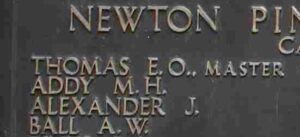
Simon James Williams, Flight Sergeant, 617504, Royal Air Force. Simon was the son of Captain John Evan Williams and Mary Williams, of Emlyn, Aberporth. He served as a Wireless Operator/ Air Gunner with 21 Squadron, Royal Air Force. The squadron was a light bomber squadron, equipped with the Bristol Blenheim, and operated from Scotland to attack German shipping of the coast of Norway. Simon was killed when his aircraft was shot down over Germany on 21 October 1941. He is buried at Sage War Cemetery, Germany.
Alan Wilson, Corporal, 319104, Royal Electrical and Mechanical Engineers. Alan was the son of Fred and Daisy Maud Wilson, and the husband of Gladys Beatrice Wilson, of Sundon Park, Luton, Bedfordshire. Alan served with the Royal Electrical and Mechanical Engineers during the war, and was probably based at RAE Aberporth afterwards. He died there on 6 March 1947, aged 31, and is buried at Aberporth (St. Cynwyl) Churchyard. Alan is not named on the Aberporth Memorial.